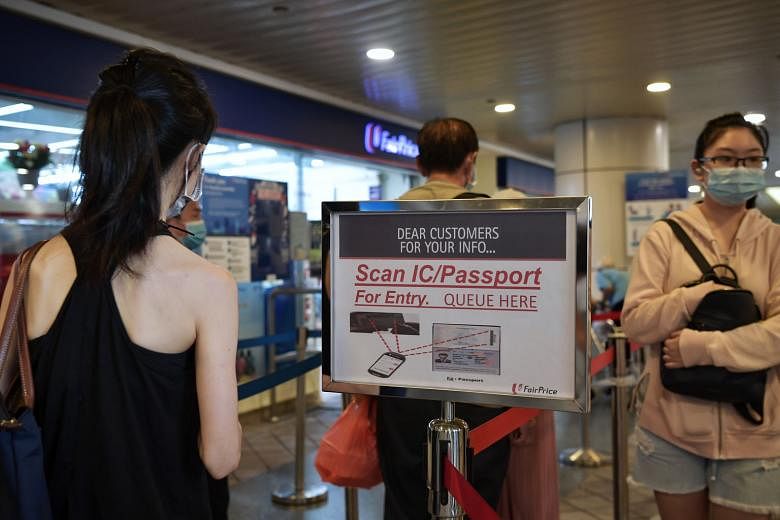About 1.1 million people - or one-fifth of Singapore's population - have downloaded the contact tracing app, TraceTogether.
But that is nowhere near enough for the tool to be deemed effective, said experts. This is because 20 per cent of the population having the app means that only 4 per cent of their contacts can be traced, said Professor Leong Thin Yin of the Singapore University of Social Sciences' business programme.
The result is derived from a mathematical formula.
If the probability of anyone having downloaded the app is P (in this case 20 per cent), the probability of establishing a trace between two random people, with both having the app, is P multiplied by P.
This leads to a result of 4 per cent, Prof Leong said.
If at least three quarters of the population download the mobile app, as recommended by National Development Minister Lawrence Wong, then the trace proportion is over one half.
Associate Professor Alex Cook, vice-dean of research at the National University of Singapore's Saw Swee Hock School of Public Health, said: "That means that over 50 per cent of all contacts of cases can be alerted and can take precautions like going for testing or self-quarantining. That could be a game changer as it might be enough to reduce the reproduction number below one."
The reproduction number of an infection indicates the average number of people who will contract a contagious disease from one person. If it is less than one, each existing infection causes less than one new infection.
TraceTogether, launched on March 20, leverages short-distance Bluetooth signals between phones to detect other participating app users in close proximity.
Its developers, the Government Technology Agency (GovTech) and the Ministry of Health, say that the app is useful when those infected cannot recall whom they had been in close proximity with for an extended duration.
The app is among several tech initiatives deployed by the Government to combat the transmission of Covid-19.
Prime Minister Lee Hsien Loong, pointing to TraceTogether as an example, said in a speech on April 21 that other apps were being developed for the purpose of tracing "more efficiently" where Covid-19 patients had visited as well as who they had been in contact with.
He said: "For these to work, we will need everyone's cooperation to install and use these apps, like what the South Koreans have done. There will be some privacy concerns, but we will have to weigh these against the benefits of being able to exit from the circuit breaker and stay open safely."
-
SafeEntry system for workplaces
-
Employers who do not have access to their own digital system to log the entry and exit information of their employees at the workplace during the circuit breaker period can make use of a SafeEntry system developed by the Government Technology Agency.
The free-for-use cloud-based system can also be used to log entry information of visitors to a location.
Users can check in and check out of a venue using the SafeEntry portal simply by scanning a QR code on their own mobile devices.
It also logs key information - including name, NRIC number and mobile number - all of which are required to support contact tracing efforts to stop the spread of Covid-19.
Users can choose to manually enter this information every time, or authenticate SingPass Mobile to pre-populate the fields.
So far, essential sector businesses such as supermarkets, clinics and food and beverage outlets at more than 2,100 locations have taken up the SafeEntry system.
A spokesman for the Smart Nation and Digital Government Office said that data collected via SafeEntry is stored in the government server, which will be accessed by the authorities only when needed for contact tracing purposes.
"The Government is the custodian of the data submitted by individuals, and there will be stringent security measures in place to safeguard access to personal data. Only authorised public officers involved in contact tracing will have access to the data when the need arises," said the spokesman.
Yip Wai Yee
Despite their potential, such apps have limitations. Prof Leong pointed out that the elderly, who are most vulnerable to Covid-19, may not even own smartphones, let alone download and activate apps.
Mr Jason Bay, GovTech's senior director of government digital services and the product lead of Trace Together, also noted in a blog post that automated contact tracing apps such as this one should not be seen as a "panacea".
He said Bluetooth-based contact tracing solutions do not, for example, automatically record environment data which would otherwise be important in establishing if an encounter between two people is a close, casual or transient contact.
"Short-duration encounters in enclosed spaces without fresh ventilation often constitute close contact, even if encounter proximity and duration do not meet algorithmic thresholds," wrote Mr Bay.
"We use TraceTogether to supplement contact tracing - not replace it," he added.

